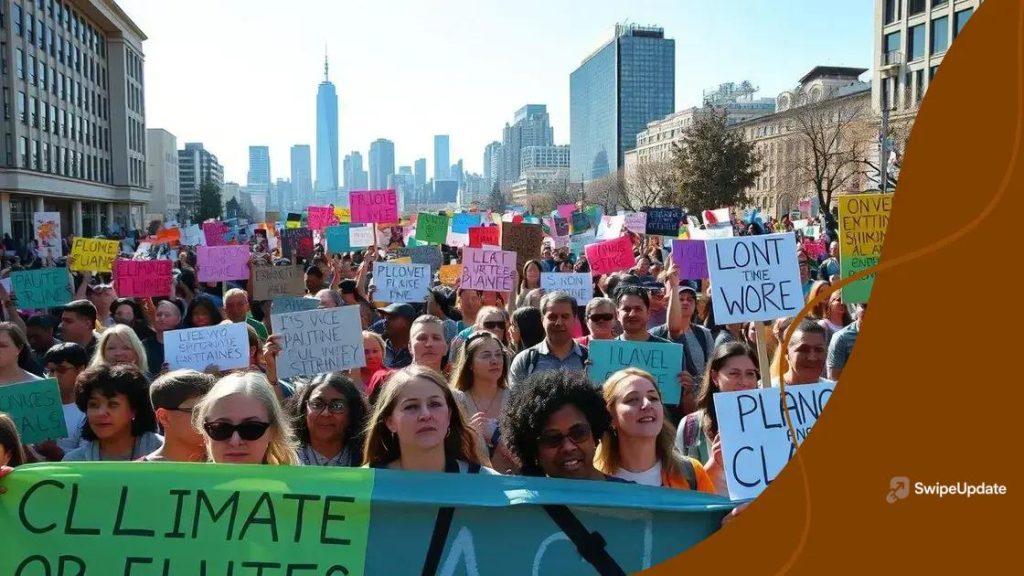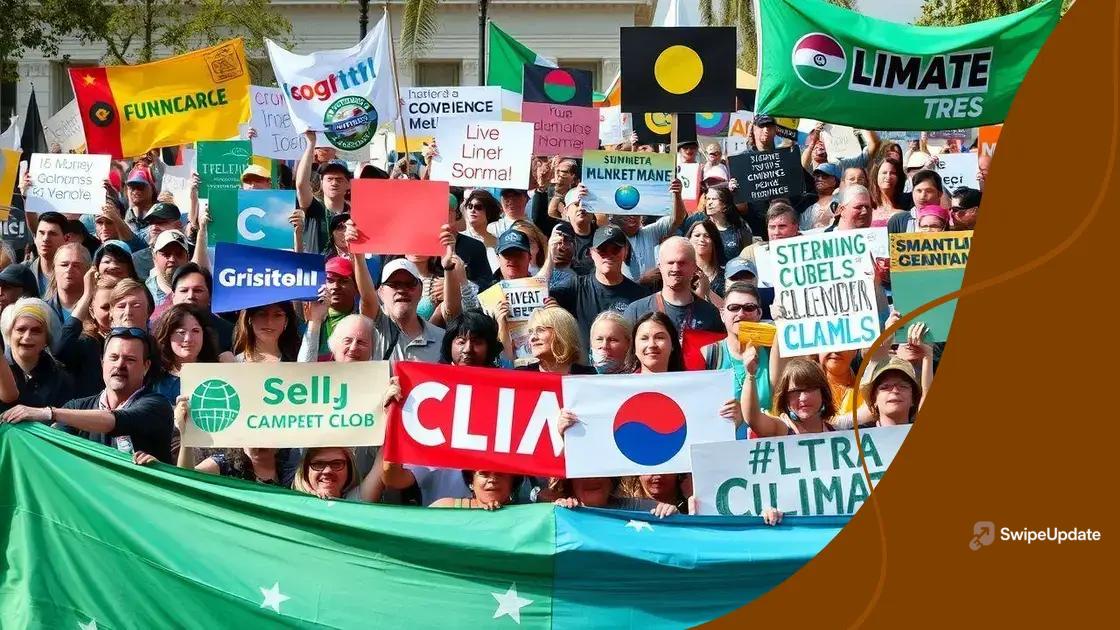Climate strike Britain: join the movement for change

Climate strikes in Britain mobilize citizens to demand urgent action on climate change, influencing policies and raising public awareness about environmental issues.
In recent years, the climate strike Britain movement has gained momentum, urging individuals to take action against climate change. Have you wondered how simple acts of protest can ignite policy change? This article delves into the essence of climate strikes and the power of collective voice.
Understanding the climate strike movement
The climate strike movement represents a vital response to the challenges posed by climate change. This global initiative encourages citizens to make their voices heard by standing together and demanding action from governments and organizations. Understanding this movement is essential for anyone interested in making a difference.
What is the climate strike movement?
At its core, the climate strike movement involves citizens participating in protests to raise awareness about climate change and push for more aggressive action. Inspired by youth activists, people of all ages have joined these strikes to express their concerns and advocate for a sustainable future.
Key events in the movement
Numerous significant climate strikes have taken place worldwide, drawing attention to the increasingly urgent need for climate action. These events often attract thousands of participants, showing a united front against inaction. Notable events include:
- Global Climate Strike in September 2019, where millions participated worldwide.
- Weekly strikes initiated by Fridays for Future, bringing in students and activists regularly.
- Localized strikes that focus on specific community issues related to climate, such as pollution and deforestation.
Such events not only raise awareness but also help influence policy decisions and bring climate issues to the forefront of political agendas. As the movement gains traction, its impact becomes more apparent in legislative discussions.
Many activists also utilize social media to amplify their messages, reaching wider audiences beyond physical protests. By sharing experiences online, they create a sense of community and accountability. This online presence helps educate others on the urgency of the climate crisis.
In addition, various organizations support the climate strike movement, providing resources, organizing events, and fostering collaboration among activists. Groups like Greta Thunberg’s Fridays for Future and many local NGOs play crucial roles in energizing communities.
Why should you join?
Participating in the climate strike movement can empower individuals to contribute to a larger cause. Joining a strike demonstrates solidarity with fellow citizens who care deeply about our planet. Your voice matters in advocating for critical changes to protect the environment and ensure a sustainable future for generations to come.
In conclusion, the climate strike movement is a powerful platform for raising awareness and driving change. By understanding its significance, you can make an informed decision about how to contribute to this global effort to combat climate change and advocate for a healthier planet.
Recent climate strikes in Britain
Recent climate strikes in Britain have shown the growing determination of citizens to address climate change. These events, led by passionate activists, emphasize the urgency of the climate crisis and demand immediate action from leaders.
Major climate strikes
One of the most notable events was the Global Climate Strike in September 2021, where thousands of people marched through major cities like London. Participants included students, families, and activists, all united under a common cause. This strike highlighted key issues like governmental responsibility, fossil fuel dependency, and the need for renewable energy solutions.
Issues addressed during the strikes
The strikes focus on various pressing topics affecting the environment and our communities. Some of the main issues discussed include:
- Demanding a reduction in greenhouse gas emissions.
- Promoting sustainable energy sources to combat climate change.
- Advocating for climate justice and support for vulnerable communities.
The energy at these events is palpable, reflecting a sense of urgency and hope among those present. Participants often carry banners that creatively illustrate their messages, making them easily understood and impactful.
Social media plays a significant role in amplifying the impact of these strikes. Many participants share their experiences and photos online, reaching a wider audience and encouraging others to join future events. Hashtags like #ClimateStrike and #FridaysForFuture help spread awareness and rally support.
Community involvement is crucial to the success of these strikes. Local organizations often help organize logistics and provide resources for participants. By bringing together individuals from various backgrounds, these events foster a spirit of collaboration that extends beyond the day of the strike.
Overall, the recent climate strikes in Britain are not just protests; they represent a powerful movement pushing for a sustainable future. The ongoing commitment from citizens demonstrates that change is possible when people unite for a shared cause.
Key figures and organizations behind the strikes

Understanding the key figures and organizations behind climate strikes helps to shed light on the movement’s effectiveness and reach. Various leaders and groups play vital roles in mobilizing supporters and advocating for action against climate change.
Prominent activists
Several young activists have emerged as powerful voices in the climate movement. They inspire others to join the fight for a sustainable future. Notably, figures like Greta Thunberg have gained international attention. Thunberg started by skipping school to protest outside the Swedish parliament, sparking a global movement.
Influential organizations
Many organizations support and drive the climate strike movement. These groups provide resources, organize events, and mobilize communities. Some of the key organizations include:
- Fridays for Future: Founded by Greta Thunberg, this group encourages students to strike for climate action every Friday.
- Climate Action Network: This international network connects various organizations dedicated to tackling climate change.
- Extinction Rebellion: A grassroots movement using nonviolent civil disobedience to demand action from governments.
Each of these organizations has its own approach, yet they all share the common goal of addressing climate change. They promote awareness through education and activism, creating impactful campaigns that resonate with the public.
The collaboration between activists and organizations amplifies their message. Their combined efforts not only attract attention but also drive change at local and global levels. Innovative strategies and creative campaigns often capture media coverage, keeping climate issues in public discourse.
As the climate strike movement evolves, new leaders and organizations continue to emerge. Their dedication and passion for the cause inspire others to join the movement and advocate for sustainable practices. With this growing network of advocates, the call for climate action becomes stronger and more unified over time.
The impact of strikes on climate policies
The impact of strikes on climate policies is significant, as these events draw attention to the urgent need for action against climate change. When citizens unite to protest, they send a strong message to governments and corporations about the need for lasting change.
Raising awareness
Climate strikes serve to increase public awareness about environmental issues. By gathering large crowds, participants highlight the pressing need for policies that address climate change. This puts pressure on decision-makers to respond and take climate issues seriously.
Influencing policy decisions
Strikes have shown to influence government policies in various ways. Key elements of this influence include:
- Creating conversations around climate legislation.
- Encouraging lawmakers to prioritize the environment in their agendas.
- Shaping public opinion on climate-related topics.
As strikes gain media coverage, key figures in governments often face increased scrutiny. This forces them to consider the demands of their constituents and act accordingly. The voices of young people, in particular, have sparked dialogues about future generations’ rights and protections.
Moreover, many politicians acknowledge the need to implement policies that align with sustainable practices. This may include investing in renewable energy, setting targets for carbon emissions, and supporting green technology initiatives. When protestors are vocal and visible, their impact reaches far beyond the streets, encouraging systemic change.
Furthermore, climate strikes can lead to international agreements and commitments. By raising global awareness, movements can prompt countries to work together on climate solutions. In this way, local actions can have a far-reaching effect, fostering international cooperation on pressing climate issues.
In summary, the impact of climate strikes on policy can be profound. As communities come together to advocate for change, their collective voices can reshape the future of climate action and drive meaningful progress toward sustainability.
How to participate in future climate strikes
Participating in future climate strikes is a great way to express your concern for the environment and advocate for change. Engaging in these events not only raises awareness but also shows support for policies that prioritize sustainability.
Find local events
The first step is to look for upcoming local strikes in your area. Many organizations announce these events on their websites or social media. Here are some ways to stay informed:
- Follow groups like Fridays for Future and Extinction Rebellion on social media.
- Sign up for newsletters from environmental organizations.
- Check community bulletin boards and local event calendars.
By attending these events, you’ll join other activists and can amplify your voice together. It’s a chance to meet like-minded people who share your passion for fighting climate change.
Prepare for the event
Before attending a strike, preparing is essential. You can:
- Create signs that reflect your message about climate change.
- Wear comfortable clothing and bring water to stay hydrated.
- Invite friends or family to join, increasing support and visibility.
Having clear, bold messages on your signs can help communicate your points effectively to passersby and media. This visibility is crucial for raising awareness on the issues at hand.
Engage with others
During the strike, it’s important to not only express your views but also engage with other participants. This creates a sense of community and solidarity. Share your thoughts and listen to others; every story can inspire further action. Connect with newcomers by explaining the importance of climate action to foster a welcoming atmosphere.
After the strike, consider discussing what you learned or enjoyed with friends and family. This can help spread the message further beyond the event itself. Sharing experiences on social media can also motivate others to participate in future strikes.
Every action counts, and participating in climate strikes is just one way to help the planet. Your involvement helps keep climate change a priority in conversations, making it more likely for governments and institutions to act.
FAQ – Frequently Asked Questions about Climate Strikes
What are climate strikes?
Climate strikes are protests where people gather to demand action on climate change and raise awareness about environmental issues.
How can I find out about upcoming climate strikes?
You can follow organizations like Fridays for Future on social media, sign up for newsletters, or check local event listings.
What should I bring to a climate strike?
Bring comfortable clothing, water, and signs that clearly communicate your message about climate action.
How do climate strikes affect policy?
Climate strikes raise public awareness and pressure governments to implement policies aimed at combating climate change.
